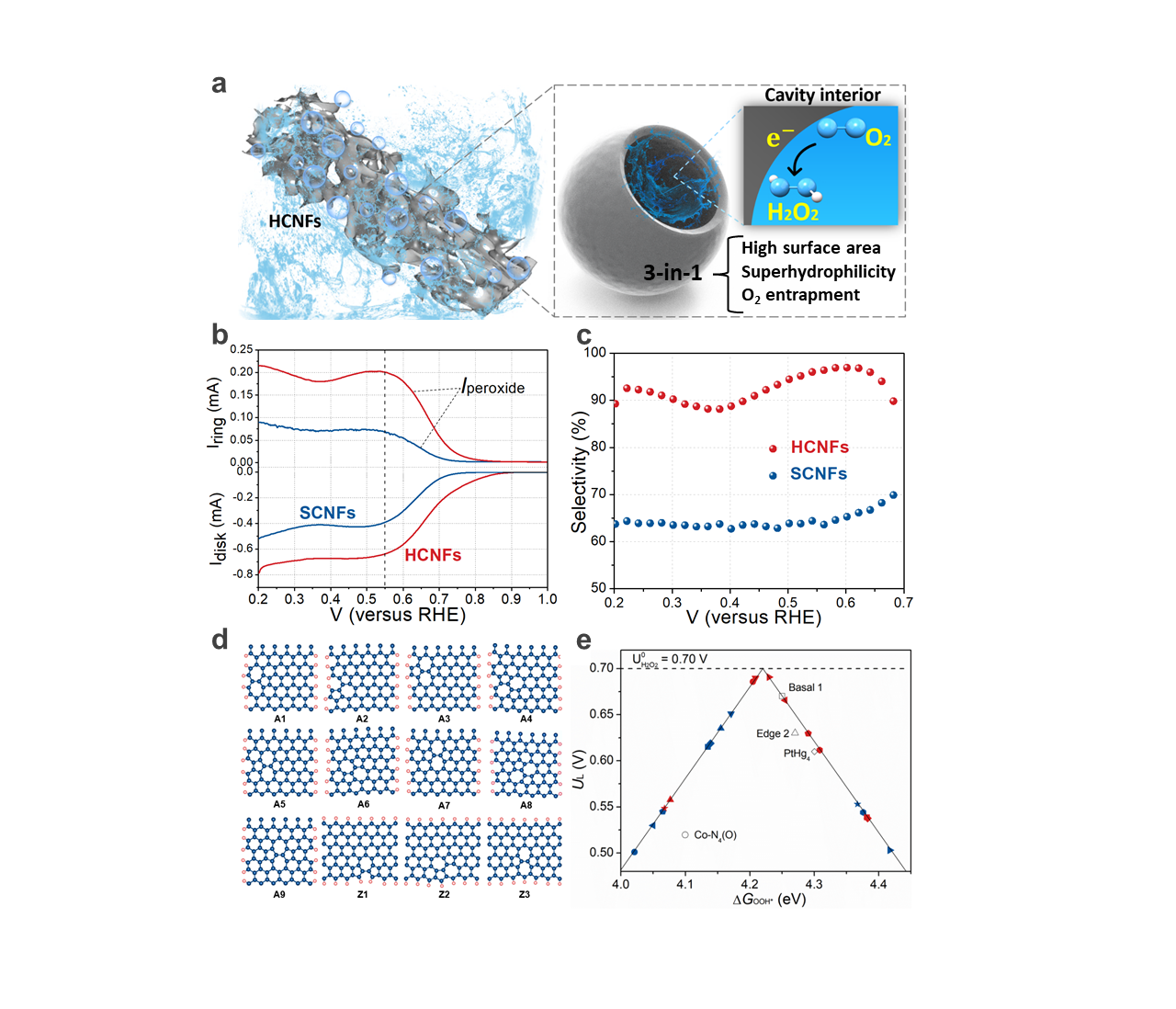Recently, associate Prof. Dongwei Ma at School of Materials cooperating with Prof. Xuping Sun from University of Electronic Science and Technology of China designed and synthesized a honeycomb carbon nanofiber (HCNF) with rich edge defects and oxygenated functional groups, by combining advanced experimental synthesis with first-principles calculations. The unique one-dimensional HCNFs possess extremely high selectivity and yield of H2O2. This work was published on the top journal in chemistry, “Angewandte Chemie International Edition”, entitled “Honeycomb Carbon Nanofibers: A Superhydrophilic O2-Entrapping Electrocatalyst Enables Ultrahigh Mass Activity for the Two-Electron Oxygen Reduction Reaction”.

Figure a) 3-in-1 effect of HCNFs promotes O2-to-H2O2 conversion. b) RRDE voltammograms of HCNFs and SCNFs for the ORR and H2O2 production (marked with Iperoxide). c) Calculated selectivity. d) Atomic structures of the AGNR and ZGNR with the SW defects locating at various positions with respect to the edges. e) Theoretical activity volcano plots (solid lines) of 2e- ORR for AGNR and ZGNR with various SW defects.
The catalytic mechanism is revealed by in-situ Raman analysis and density functional theory calculations. The interconnected nanocavities in the HCNFs not only favor exposure of more defective active sites and facilitate mass transfer/diffusion of the reactants, but ensure effective entrapping of O2 gas to promote further the binding/interaction of catalyst with O2 molecules. Further theoretical calculations show that the superb two-electron (2e-) oxygen reduction reaction (ORR) activity stems from the synergetic effect between edges and topological defects, which could facilitate the HCNFs to produce rich active sites (near the vertex of the volcano plots, corresponding to the thermodynamic equilibrium potential of 0.70 V) for 2e- ORR. In addition, it is also verified from the theoretical calculations that, the catalytic activity of those sites near the edge of armchair graphene nanoribbons is higher than those near the edge of zigzag graphene nanoribbons, that are mainly at the intersection of pentagon and heptagon. These theoretical studies not only confirm that the synergetic effect between edges and topological defects could enhance the 2e- ORR activity of carbon nanomaterials, but would open up an exciting new avenue to the design of 2e- ORR catalysts with higher activity and selectivity.
As one of the most important fundamental chemicals, H2O2 has been found widespread applications in modern chemical industry as well as energy and environment fields. It is currently produced by the high energy consumption anthraquinone cycle process, which requires large plants to minimize capital investment, meanwhile, results in huge of organic waste and by-products as well. Electrochemical 2e- ORR is regarded as an attractive green method for on-site direct H2O2 production. However, the strong competition from the four-electron (4e-) ORR always results in the low selectivity of 2e‑ ORR. Therefore, developing highly selective electrocatalysts is the greatest challenges of H2O2 production by 2e- ORR. Employing the strategy of space confinement and constructing edge topological defects, Prof. Sun and Prof. Ma have made an important breakthrough in this field in the light of experimental synthesis and theoretical calculations. Electrochemical tests show the HCNFs are robust and capable of achieving a high H2O2 selectivity of 97.3%, much higher than that of its solid carbon nanofiber counterpart. Impressively, this catalyst achieves an ultrahigh mass activity of up to 220 A g-1, surpassing all other catalysts for 2e- ORR. Thanks to this significant discovery, this work was selected as the VIP(Very Important Paper)by the journal of “Angewandte Chemie International Edition”.
Prof. Sun from University of Electronic Science and Technology of China, Associate Prof. Ma from School of Materials, and Prof. Li from Sichuan Normal University are the co-corresponding authors of this paper. Yuanyuan Wang, a master in the School of Materials, has completed all the theoretical calculations in this paper. This work was supported by the National Natural Science Foundation of China.
The link of this paper:
https://onlinelibrary.wiley.com/doi/10.1002/anie.202101880.